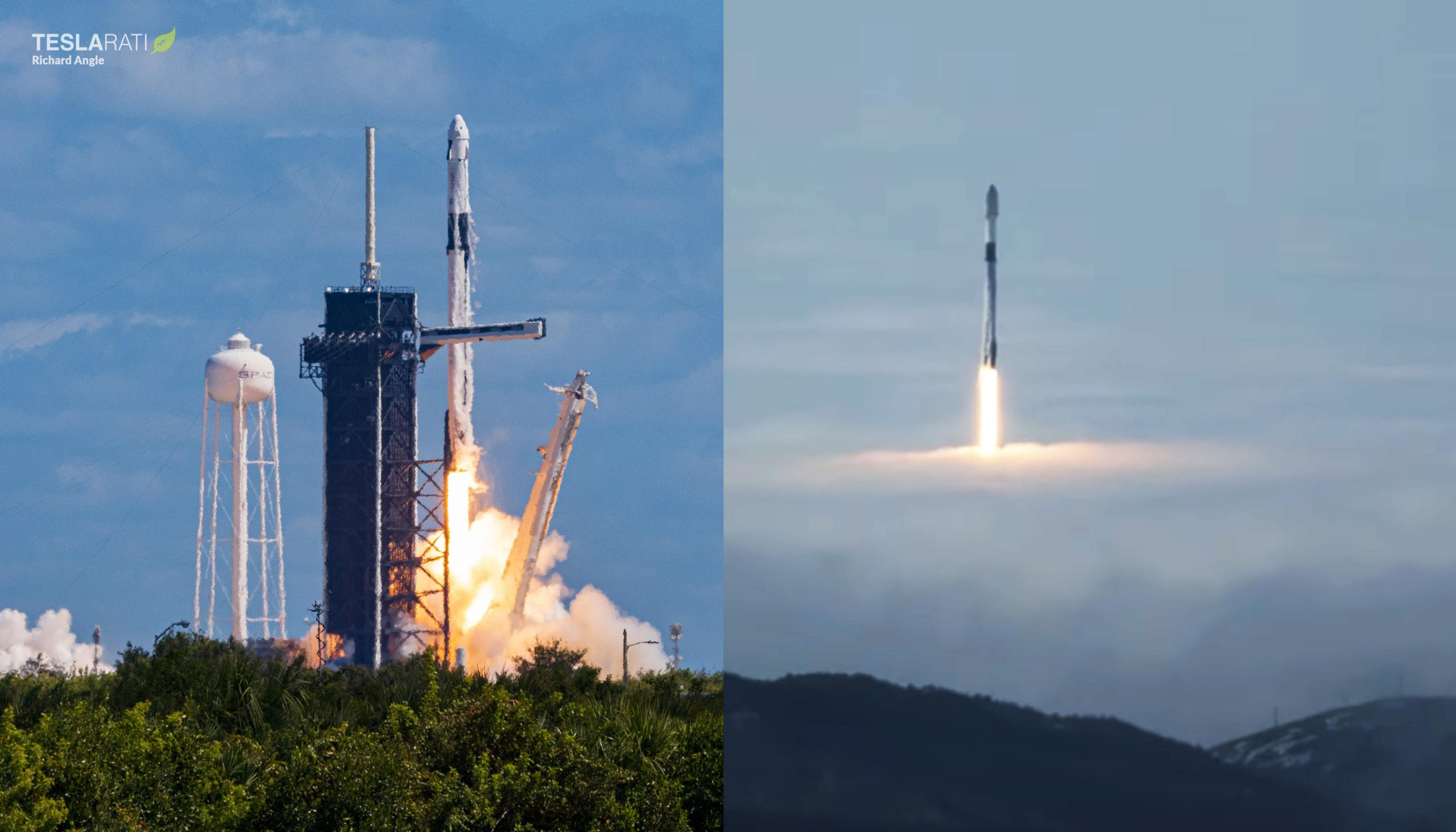
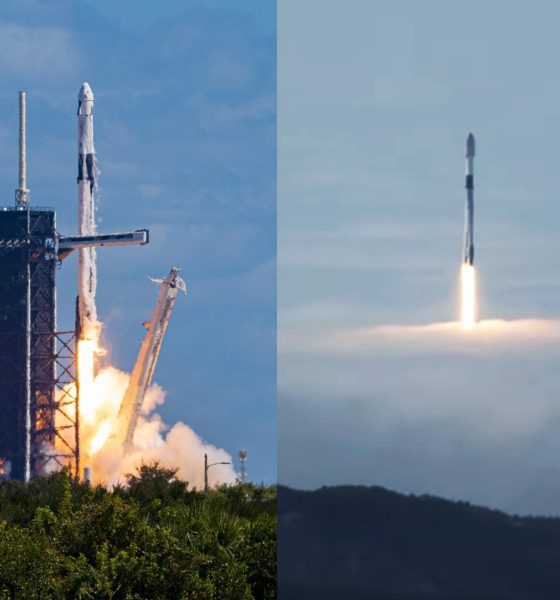
News
SpaceX launches two Falcon 9 rockets in seven hours
Two SpaceX Falcon 9 rockets have successfully launched a Crew Dragon carrying four astronauts and a new batch of Starlink internet satellites a little over 7 hours apart, nearly halving the company’s previous record.
A Falcon 9 rocket on the East Coast kicked things off with a launch out of NASA’s Kennedy Space Center (KSC) LC-39A pad – leased by SpaceX since 2014 – at noon EDT (16:00 UTC). A rare new Falcon 9 booster lifted an expendable upper stage and flight-proven Crew Dragon capsule – carrying four professional astronauts – most of the way free from Earth’s atmosphere before heading back to Earth and landing without issue on a SpaceX drone ship. The upper stage continued to low Earth orbit and deployed Dragon, kicking off a 29-hour journey to the International Space Station (ISS).
Seven hours and ten minutes later, a second Falcon 9 rocket lifted off from SpaceX’s Vandenberg Space Force Base (VSFB) SLC-4E pad, bursting through a thick layer of coastal fog. Following a successful launch and landing of booster B1071 and two good burns of the rocket’s upper stage, Falcon 9 deployed another 52 Starlink V1.5 satellites, adding to the more than 3000 working satellites already in orbit.
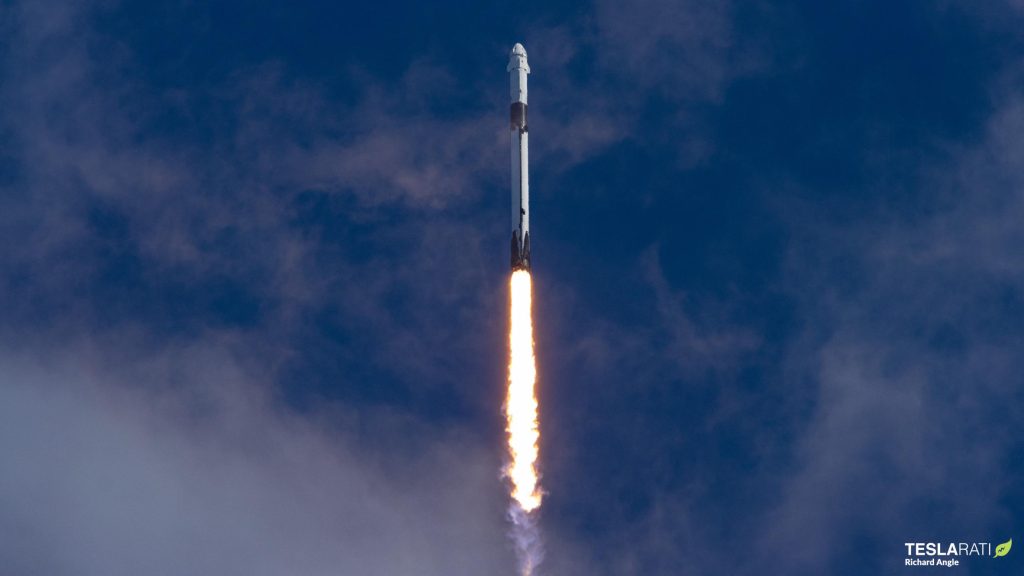
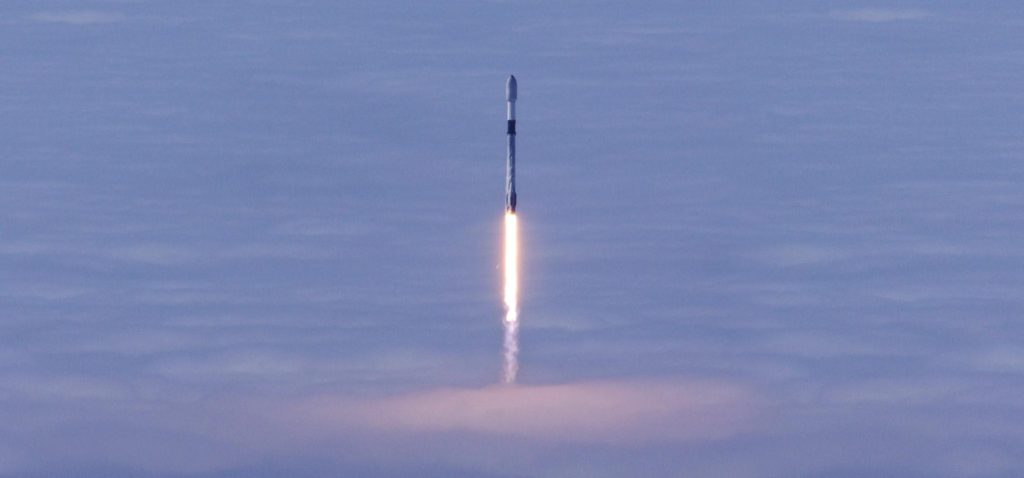
And SpaceX isn’t done. As early as 7:07 pm EDT (23:07 UTC) on October 6th, less than 24 hours after Starlink 4-29, a third Falcon 9 rocket is scheduled to launch from SpaceX’s Cape Canaveral Space Force Station (CCSFS) LC-40 pad. Rounding out the trio, the mission will carry Intelsat’s Galaxy 33 and Galaxy 34 communications satellites into a geostationary transfer orbit (GTO).
The mission will be Falcon 9 booster B1060’s 14th launch, significantly raising the bar for the commercial acceptance of reused SpaceX rockets. Prior to Galaxy 33/34, SpaceX’s commercial reuse record was held by Transporter-3, which was Falcon 9 B1058’s tenth launch.
The completion of two Falcon 9 launches in a little over 7 hours nearly halves SpaceX’s previous record of 14 hours and 8 minutes, set by a pair of launches in June 2022. It also demonstrates that the company can repeatedly prepare for and complete multiple Falcon 9 launches in very close proximity – more or less a necessity if it wants to hit CEO Elon Musk’s unprecedented target of “up to 100 launches” in 2023.
It isn’t a record for all of spaceflight, however. That likely falls to the Soviet R-7 family of rockets, 2 of which launched just 25 minutes apart in 1969. However, 3 Falcon 9 launches in 31 hours (Crew-5, Starlink 4-29, and Galaxy 33/34) is likely a record for all rockets. Parsing astrophysicist Jonathan McDowell’s extensive records, the R-7 family likely held the record for decades after completing 3 launches in 40 hours in 1978.
But, as it turns out, SpaceX already beat that record when it launched 3 Falcon 9 rockets in 36 hours in June 2022. 3 Falcon 9 launches in 31 hours thus breaks SpaceX’s record and the world record. That’s become an increasingly common occurrence for a company that has beaten its competitors so thoroughly that, by many measures, it has become peerless. Now, only the records of the former Soviet Union and a retired NASA rocket can outmatch SpaceX, a single 20-year-old company.
In less than three years, SpaceX has launched 30 astronauts: more than twice as many as China but a tiny fraction of the 852 people NASA’s Space Shuttle launched over its 30-year career. SpaceX’s Falcon family of rockets is the most reliable in history after 154 consecutive successes in less than six years, and Falcon boosters have completed more successful landings (145) than Space Shuttle orbiters. But its Dragon spacecraft will likely never best the Soviet and Russian Soyuz capsule and its variants, and Falcon will almost certainly be retired before it can come close to the R-7 rocket family’s extraordinary record of 1844 launches over 65 years.
But in the modern era, SpaceX is simply unmatched.
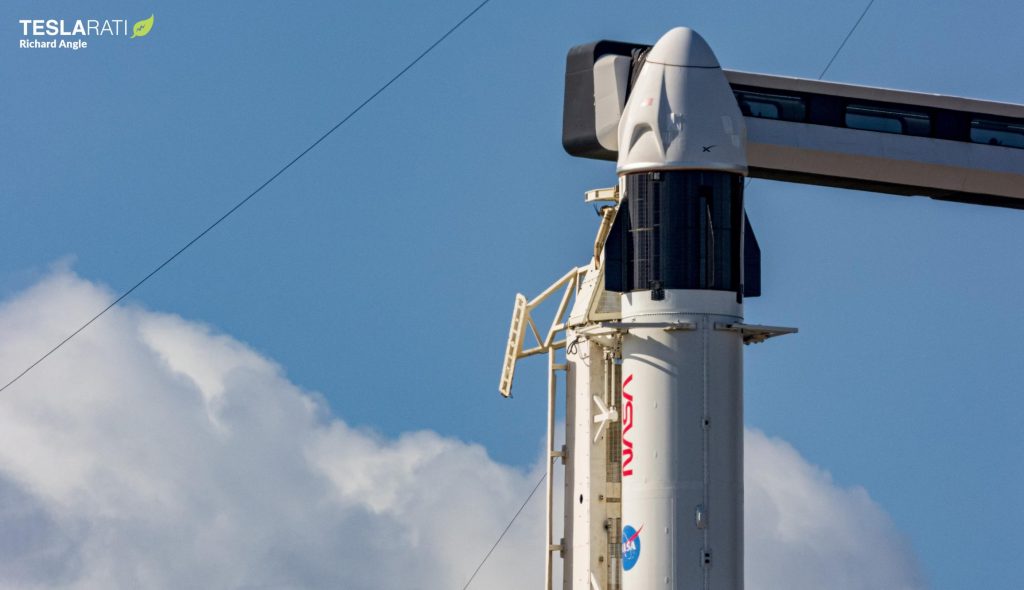
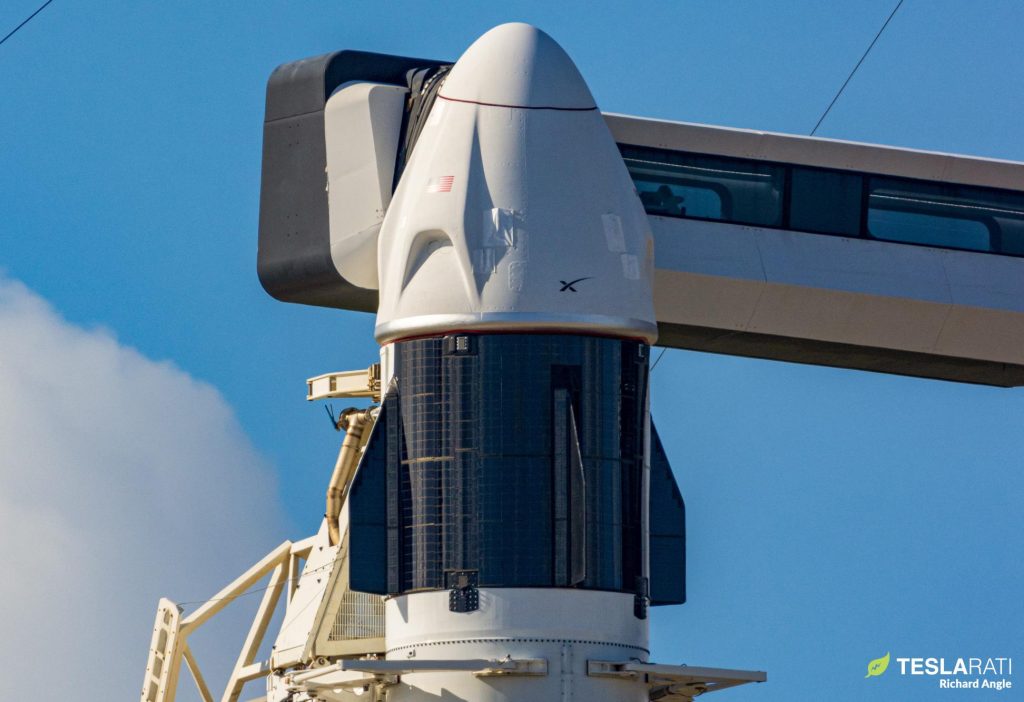
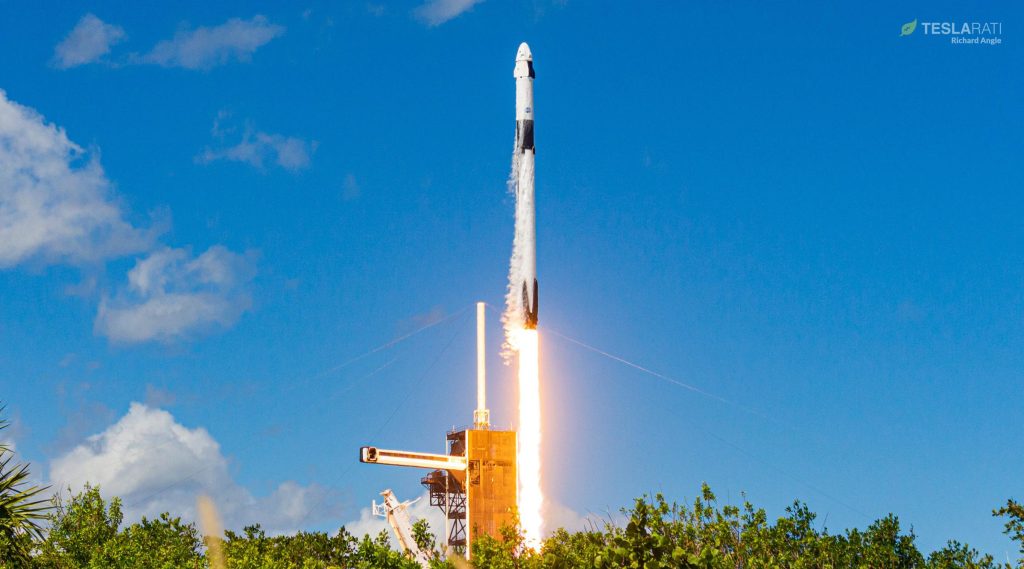
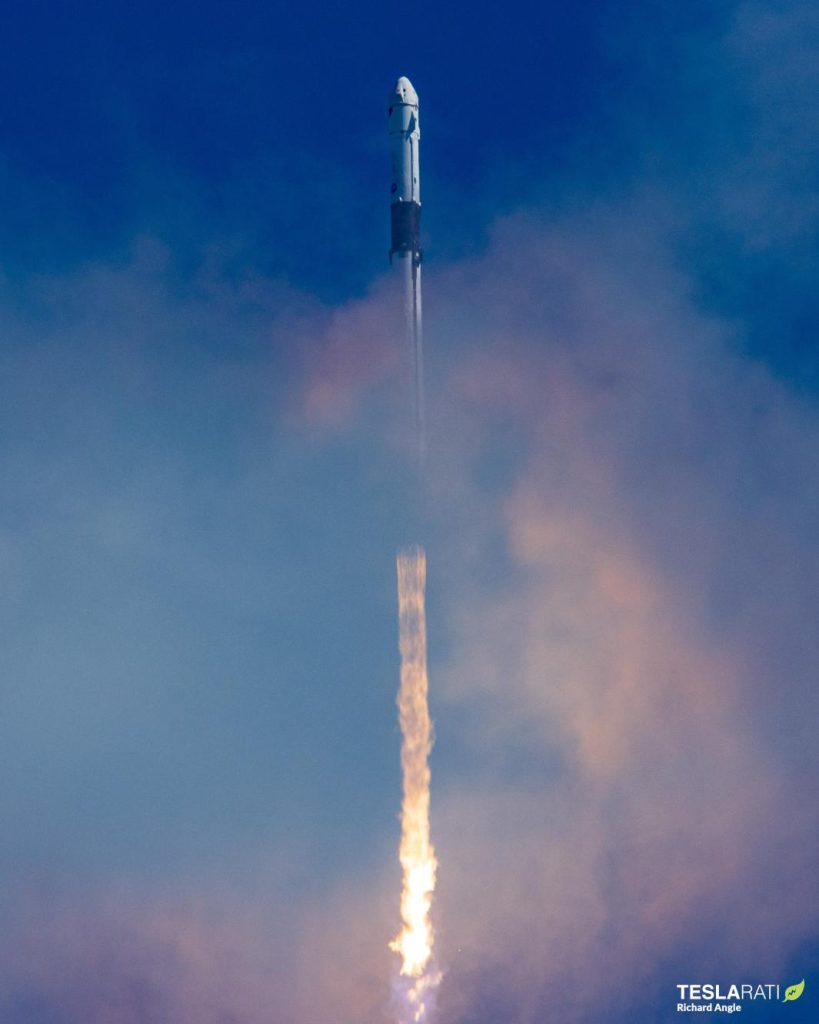

News
Tesla Full Self-Driving v14.2 – Full Review, the Good and the Bad

Tesla rolled out Full Self-Driving version 14.2 yesterday to members of the Early Access Program (EAP). Expectations were high, and Tesla surely delivered.
With the rollout of Tesla FSD v14.2, there were major benchmarks for improvement from the v14.1 suite, which spanned across seven improvements. Our final experience with v14.1 was with v14.1.7, and to be honest, things were good, but it felt like there were a handful of regressions from previous iterations.
While there were improvements in brake stabbing and hesitation, we did experience a few small interventions related to navigation and just overall performance. It was nothing major; there were no critical takeovers that required any major publicity, as they were more or less subjective things that I was not particularly comfortable with. Other drivers might have been more relaxed.
With v14.2 hitting our cars yesterday, there were a handful of things we truly noticed in terms of improvement, most notably the lack of brake stabbing and hesitation, a major complaint with v14.1.x.
However, in a 62-minute drive that was fully recorded, there were a lot of positives, and only one true complaint, which was something we haven’t had issues with in the past.
The Good
Lack of Brake Stabbing and Hesitation
Perhaps the most notable and publicized issue with v14.1.x was the presence of brake stabbing and hesitation. Arriving at intersections was particularly nerve-racking on the previous version simply because of this. At four-way stops, the car would not be assertive enough to take its turn, especially when other vehicles at the same intersection would inch forward or start to move.
This was a major problem.
However, there were no instances of this yesterday on our lengthy drive. It was much more assertive when arriving at these types of scenarios, but was also more patient when FSD knew it was not the car’s turn to proceed.
Can report on v14.2 today there were ZERO instances of break stabbing or hesitation at intersections today
It was a significant improvement from v14.1.x
— TESLARATI (@Teslarati) November 21, 2025
This improvement was the most noticeable throughout the drive, along with fixes in overall smoothness.
Speed Profiles Seem to Be More Reasonable
There were a handful of FSD v14 users who felt as if the loss of a Max Speed setting was a negative. However, these complaints will, in our opinion, begin to subside, especially as things have seemed to be refined quite nicely with v14.2.
Freeway driving is where this is especially noticeable. If it’s traveling too slow, just switch to a faster profile. If it’s too fast, switch to a slower profile. However, the speeds seem to be much more defined with each Speed Profile, which is something that I really find to be a huge advantage. Previously, you could tell the difference in speeds, but not in driving styles. At times, Standard felt a lot like Hurry. Now, you can clearly tell the difference between the two.
It seems as if Tesla made a goal that drivers should be able to tell which Speed Profile is active if it was not shown on the screen. With v14.1.x, this was not necessarily something that could be done. With v14.2, if someone tested me on which Speed Profile was being used, I’m fairly certain I could pick each one.
Better Overall Operation
I felt, at times, especially with v14.1.7, there were some jerky movements. Nothing that was super alarming, but there were times when things just felt a little more finicky than others.
v14.2 feels much smoother overall, with really great decision-making, lane changes that feel second nature, and a great speed of travel. It was a very comfortable ride.
The Bad
Parking
It feels as if there was a slight regression in parking quality, as both times v14.2 pulled into parking spots, I would have felt compelled to adjust manually if I were staying at my destinations. For the sake of testing, at my first destination, I arrived, allowed the car to park, and then left. At the tail-end of testing, I walked inside the store that FSD v14.2 drove me to, so I had to adjust the parking manually.
This was pretty disappointing. Apart from parking at Superchargers, which is always flawless, parking performance is something that needs some attention. The release notes for v14.2. state that parking spot selection and parking quality will improve with future versions.
Any issues with parking on your end? 14.1.7 didn’t have this trouble with parking pic.twitter.com/JPLRO2obUj
— TESLARATI (@Teslarati) November 21, 2025
However, this was truly my only complaint about v14.2.
You can check out our full 62-minute ride-along below:
Elon Musk
SpaceX issues statement on Starship V3 Booster 18 anomaly
The incident unfolded during gas-system pressure testing at the company’s Massey facility in Starbase, Texas.

SpaceX has issued an initial statement about Starship Booster 18’s anomaly early Friday. The incident unfolded during gas-system pressure testing at the company’s Massey facility in Starbase, Texas.
SpaceX’s initial comment
As per SpaceX in a post on its official account on social media platform X, Booster 18 was undergoing gas system pressure tests when the anomaly happened. Despite the nature of the incident, the company emphasized that no propellant was loaded, no engines were installed, and personnel were kept at a safe distance from the booster, resulting in zero injuries.
“Booster 18 suffered an anomaly during gas system pressure testing that we were conducting in advance of structural proof testing. No propellant was on the vehicle, and engines were not yet installed. The teams need time to investigate before we are confident of the cause. No one was injured as we maintain a safe distance for personnel during this type of testing. The site remains clear and we are working plans to safely reenter the site,” SpaceX wrote in its post on X.
Incident and aftermath
Livestream footage from LabPadre showed Booster 18’s lower half crumpling around the liquid oxygen tank area at approximately 4:04 a.m. CT. Subsequent images posted by on-site observers revealed extensive deformation across the booster’s lower structure. Needless to say, spaceflight observers have noted that Booster 18 would likely be a complete loss due to its anomaly.
Booster 18 had rolled out only a day earlier and was one of the first vehicles in the Starship V3 program. The V3 series incorporates structural reinforcements and reliability upgrades intended to prepare Starship for rapid-reuse testing and eventual tower-catch operations. Elon Musk has been optimistic about Starship V3, previously noting on X that the spacecraft might be able to complete initial missions to Mars.
Investor's Corner
Tesla analyst maintains $500 PT, says FSD drives better than humans now
The team also met with Tesla leaders for more than an hour to discuss autonomy, chip development, and upcoming deployment plans.

Tesla (NASDAQ:TSLA) received fresh support from Piper Sandler this week after analysts toured the Fremont Factory and tested the company’s latest Full Self-Driving software. The firm reaffirmed its $500 price target, stating that FSD V14 delivered a notably smooth robotaxi demonstration and may already perform at levels comparable to, if not better than, average human drivers.
The team also met with Tesla leaders for more than an hour to discuss autonomy, chip development, and upcoming deployment plans.
Analysts highlight autonomy progress
During more than 75 minutes of focused discussions, analysts reportedly focused on FSD v14’s updates. Piper Sandler’s team pointed to meaningful strides in perception, object handling, and overall ride smoothness during the robotaxi demo.
The visit also included discussions on updates to Tesla’s in-house chip initiatives, its Optimus program, and the growth of the company’s battery storage business. Analysts noted that Tesla continues refining cost structures and capital expenditure expectations, which are key elements in future margin recovery, as noted in a Yahoo Finance report.
Analyst Alexander Potter noted that “we think FSD is a truly impressive product that is (probably) already better at driving than the average American.” This conclusion was strengthened by what he described as a “flawless robotaxi ride to the hotel.”
Street targets diverge on TSLA
While Piper Sandler stands by its $500 target, it is not the highest estimate on the Street. Wedbush, for one, has a $600 per share price target for TSLA stock.
Other institutions have also weighed in on TSLA stock as of late. HSBC reiterated a Reduce rating with a $131 target, citing a gap between earnings fundamentals and the company’s market value. By contrast, TD Cowen maintained a Buy rating and a $509 target, pointing to strong autonomous driving demonstrations in Austin and the pace of software-driven improvements.
Stifel analysts also lifted their price target for Tesla to $508 per share over the company’s ongoing robotaxi and FSD programs.








